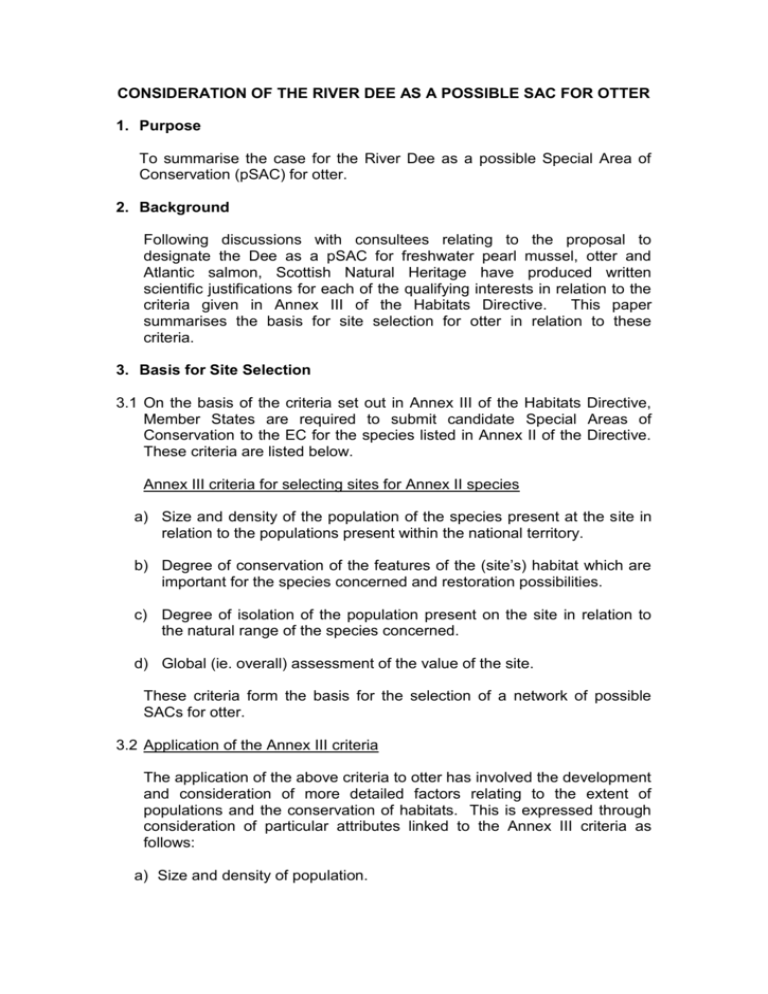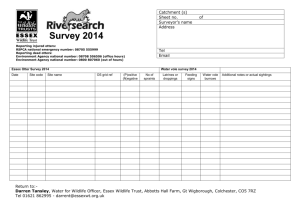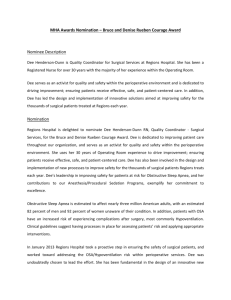consideration of the river dee as a possible sac for salmon
advertisement

CONSIDERATION OF THE RIVER DEE AS A POSSIBLE SAC FOR OTTER 1. Purpose To summarise the case for the River Dee as a possible Special Area of Conservation (pSAC) for otter. 2. Background Following discussions with consultees relating to the proposal to designate the Dee as a pSAC for freshwater pearl mussel, otter and Atlantic salmon, Scottish Natural Heritage have produced written scientific justifications for each of the qualifying interests in relation to the criteria given in Annex III of the Habitats Directive. This paper summarises the basis for site selection for otter in relation to these criteria. 3. Basis for Site Selection 3.1 On the basis of the criteria set out in Annex III of the Habitats Directive, Member States are required to submit candidate Special Areas of Conservation to the EC for the species listed in Annex II of the Directive. These criteria are listed below. Annex III criteria for selecting sites for Annex II species a) Size and density of the population of the species present at the site in relation to the populations present within the national territory. b) Degree of conservation of the features of the (site’s) habitat which are important for the species concerned and restoration possibilities. c) Degree of isolation of the population present on the site in relation to the natural range of the species concerned. d) Global (ie. overall) assessment of the value of the site. These criteria form the basis for the selection of a network of possible SACs for otter. 3.2 Application of the Annex III criteria The application of the above criteria to otter has involved the development and consideration of more detailed factors relating to the extent of populations and the conservation of habitats. This is expressed through consideration of particular attributes linked to the Annex III criteria as follows: a) Size and density of population. b) Degree of conservation of features of the habitat. i. ii. iii. iv. v. Water quality and extent of pollution. Extent and variety of suitable habitat Extent of disturbance Extent of physical modification. Quality of present river management regime. c) Degree of isolation. i. Assessment of contribution to range. d) Finally, in light of the above, a general assessment is made as to the value of the River Dee cathment and its suitability as a possible site for otter. 3.3 Evaluation against criteria The evaluation against the Annex III criteria and the specific areas of detail identified is set out below. a) Size and density of the population (GRADING: C). Assessing otter population size is difficult. However, the population of otter in the Dee catchment is estimated at 40-50 adults. The presence of otters has also been recorded extensively throughout the Dee catchment. Otters tend to occur at relatively low density and have a widespread distribution in Scotland (which is a European stronghold for the species) and so, inevitably, this represents a relatively small proportion of the overall UK population. It is, never the less, a good quality site for the species and represents an extensive population within a single catchment. b) Degree of conservation of habitat features (GRADING: B). i. Water quality and extent of pollution. This attribute relates to the high water quality of the river and absence of pollution from much of its length. This is essential for the maintenance of the otter population. There is a very weak nutrient gradient along the river’s length, but the River Dee is essentially a nutrient poor river with largely pristine water quality. ii. Extent and variety of suitable habitat There are a range of suitable habitats for resting, breeding and foraging in the catchment. These include the river itself, tributaries, small streams, open water bodies and wetlands, and associated features such as islands, banks, and open water transitions, and habitats such as scrub and woodland, tall herb vegetation, bog, fen and swamp. iii. Extent of disturbance Human acitivity, potentially causing disturbance to otters, is concentrated around settlements such as Aboyne and Banchory and in particular Aberdeen, and along roads such as the A93 ‘north Deeside’ road, as well as occuring more widely at lower levels thoughout the catchment as a result of variety of landuses. Along the river and tributaries, and on some of the open water bodies, rod-fishing, and maintenance and management associated with the fishery cause occasional disturbance, generally at low levels. Collisions with road traffic is a cause of mortality. Otter carcasses have been recovered along most of the lower half of the river, from Ballater to Aberdeen beach - the vast majority having died as a result of traffic accidents. Of the major roads, the A93 ‘north Deeside’ road runs the majority of the length of the Dee from from Aberdeen to Braemar in the upper part of the catchment. On the south side of the river, the A943 links Banchory with Aberdeen, and there are various minor roads linking these and other settlements, including the B993/B976 between Potarch and Ballater. Bridges over the Dee provide crossings at several localities on Deeside, and for the main routes to Aberdeen. On north Deeside, sections of the disused railway line between Aberdeen and Ballater have been developed for use by both walkers and cyclists. In the vicinity of settlements and crossings, the river is used by members of the local community for informal recreation, principally walking but also on occasions picnicking and swimming. Paths and tracks along its upper reaches are widely used by hillwalkers and mountaineers en route to the summits of the Cairngorms and eastern Grampians. The river is also used by canoiests and in its lower reaches by Aberdeen boat club. Several golf courses occur in the valley bottom, close to the river. Near the mouth of the river, Aberdeen harbour is the largest port in NE Scotland. iv. Extent of physical modification (e.g. flow regulation, channel works, barriers to movement and migration). The roads and settlements within the catchment form partial barriers to otter movement. There are few barriers to salmonid migration within either the lower or upper sections of the catchment. This may partly explain sightings of otter throughout the catchment, including at unusually high altitudes in the upper part of the catchment. Although there are no barriers to migration in the River Dee there are structures that alter local flow regimes such as instream croys and pools for fishery management purposes. Bank works have been undertaken in a number of localities to protect fishing, sporting and agricultural interests. v. Present river management regime Salmon fisheries management on the River Dee is undertaken by the Dee DSFB and by the salmon proprietors. Although the board has an enlightened approach to fisheries management, some fishing interests have partly blamed the otter for the decline in salmon stocks. Measures to prevent deterioration of water quality and habitat will strengthen this attribute. c) Degree of isolation (GRADING: C). The site is well within the natural range of otter in the UK. Radiotracking studies have shown that otters in the Dee catchment are not isolated from populations in adjacent catchments. i. Assessment of contribution to range. The proposed network of sites for otter in Scotland comprises about 40 sites. The large East coast rivers are represented by the Tweed, Spey and the Dee. The inclusion of the River Dee adds a an important refinement to range representation by filling a large gap between the Tweed and the Spey. d) Global assessment (GRADING: B). The River Dee is a high quality site otter which encompasses a large area and supports a good otter population, with habitat suitable for resting and breeding, and extensive habitat suitable for foraging, along the river and in the wider catchment. The population contributes significantly to the overall resource and particularly the range within the SAC series. The Dee catchment is largely unaltered and provides habitat for salmonids and other prey species, and is of a pristine water quality from source to sea. In the context of the Annex III criteria, the River Dee therefore appears to be an appropriate site to select as a pSAC for otter. 4. Other qualifying interests The Dee has been proposed as a pSAC because of the strong freshwater pearl mussel population in the river (global ‘A’ grade) in combination with the very important salmon population (global ‘B’ grade) and good otter population (global ‘B’ grade). The proposal to designate the site as a pSAC, therefore, lists the above three interests. 5. Boundaries The upstream and downstream site boundaries coincide with the limit of distribution for salmon. The lateral boundaries have been drawn along the river to include essential habitat for otter., following features such as banks, tracks and fence lines.





